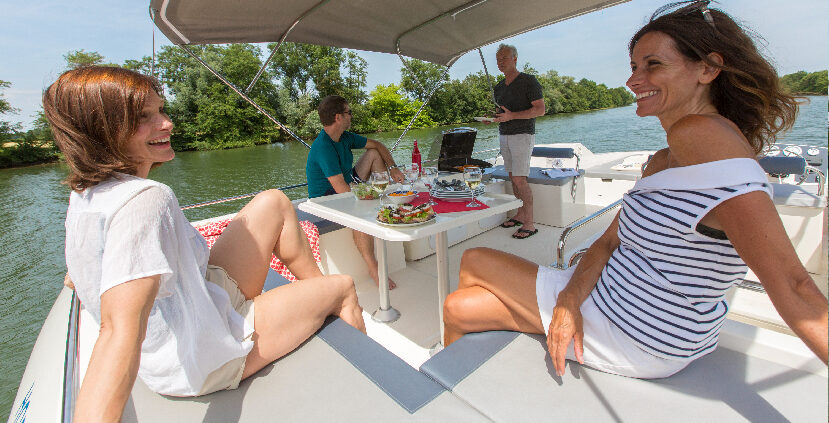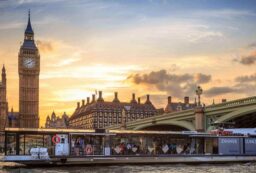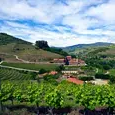
The Caledonian Canal flows from Fort William on Scotland’s western Atlantic coast and through to Inverness on the North Sea. This waterway is an epic journey which provides a stunning panorama of Scottish Highlands Life.
Millions of years ago two tectonic plates crashed. They created a violent gash from Scotland to Newfoundland. Over the following centuries, Scotland’s rains filled the Lochs of Lochy, Oich and Ness. Then the lochs waited and waited for millennia. Finally, engineer Thomas Telford had a vision to create the Caledonian Canal.
The canal takes a peaceful journey through dark lochs. Lone anglers intently fishing for pike, salmon and trout. White waders drill the shallows. Lizards sunbathe on the rocks. Eagles and ospreys fly high above tree lines of pines and Norwegian Spruce.

Laggan Locks
At the Caledonian Canal’s midpoint at Laggan Locks sits Le Boat’s base. A lone bagpiper plays a lament that lingers with the mist over the waters. He dresses in a kilt to assert his national heritage.
History hangs heavy in the Highlands and the spirit of Braveheart is never quite forgotten. The first shots of the 1745 Jacobite rebellion against English oppression are still remembered. Those shots are quietly celebrated. At Culloden, immersive displays tell the story of the battlefield where English redcoats defeated Bonnie Prince Charlie’s forces.

From Le Boat’s harbour at Laggan Locks cruisers depart to explore the Caledonian Canal. They can head north through Fort Augustus and 23 miles of Loch Ness to Inverness. Alternatively, they head south to Fort William with Le Boat providing boats sleeping from 2 to 12. After an hour or so of tuition even novices are ready to set sail on the Caledonian Canal.
Then from Fort Augustus, the Caledonian Canal flows on past the pepper pot lighthouses and the man-made timber lattice islands of the crannogs. They were constructed centuries ago to help defend Fort Augustus from water-borne raids. Then it is on into Loch Ness’ and its deep waters.
"History hangs heavy in the Highlands, the spirit of Braveheart never quite forgotten"

In the early decades of the nineteenth century, a trio of lochs Lochy, Oich and Ness were linked by Thomas Telford’s Caledonian Canal. Fifteen yards deep, the canal was hewn out of the rock by Highlands labourers. They had to supply their own shovel and axe but were paid a guinea a week.
Scotland’s greatest civil engineering project of the age finally opened, very late and considerably over budget, in October 1822. Yet, it was already almost obsolete. Steamships were replacing sail. Napoleon had been defeated at Waterloo and the seas were a safer place. The Caledonian Canal’s future lay with leisure. Today, it is the likes of Le Boat’s stylish motor cruisers which keep the friendly lock-keepers busy.

The first tip for setting sail from Laggan Locks is – don’t. Linger for a while, after all this is slow travel. Take a walk along a stretch of the Great Glen Way. Maybe cast a glinting lure to catch the legendary pike that lurk in the depths below the pontoon. On our day of arrival a 21 pounder had been reeled in. Child’s play compared to the 55-pound salmon caught in Loch Ness back in 1952.
Book a meal at The Eagle Barge, just yards from the lock. It is a Dutch barge converted into a floating bar and restaurant. This is a place to try your first haggis of the voyage. Or even first vegan haggis where beans, pulses and veg replace the traditional lamb. Obviously served with a whisky sauce, whether it is vegan or not.
A prophecy
Fort Augustus, the name is another legacy from the decades of rebellion, is a sensible first port of call. The Caledonian Canal Centre tells the story of the canal, right from the Braham Seer’s 17th century vision that “The time will come when full-rigged ships will be seen sailing eastwards and westwards by the back of Tomnahurich, near Inverness.” Though as a Seer, he had his off days. By the time the canal was complete there were few sail ships. Then when Scotland’s take on Nostradamus prophesied that Lady Seaforth’s husband was having affairs in Paris, she had Dark Kenneth, as the seer was known locally, burned to death in a tub of tar.
Exhibitions at the centre, range from the mud, sweat and tears of the labourers, through the grand opening of 1822 – not attended by the shy engineer Telford – and onto Queen Victoria’s rapid one-day steamer passage through the canal in 1873. “Wonderful” but “tedious” was her succinct verdict.
"it is hard not to harbour a suspicion that something mysteriously lurks in the depths"
Mysterious Loch Ness
Scientists argue that no long necked monster could survive in Loch Ness. The dark peaty water is never warmer than 6 centigrade. Arctic char were only discovered in the 1980s but they are the Loch’s most numerous species. It is hard not to believe that a mysterious monster lurks below and at Drumnadrochit the Loch Ness Centre and Exhibition explores myths and legends that date back to the 6th century.

The world’s greatest railway
At the western end of the canal, lies another highlight, The Jacobite. Twice a day, the train which is famous for its part in the Harry Potter films, departs from Fort William. The red steam train chuffs along the Western Highlands Railway. Often acclaimed as the world’s greatest railway, this is a line which weaves its way through a spectacular landscape. It meanders past lochs, pine-clad hillsides, sparkling brooks and remote white-sand beaches. Mallaig is the end of the line. This quiet sea-side port, is renowned for its fresh seafood. Then, in another boat, you can take a seal-spotting voyage but before catching the return train make time for dessert. Cranchan is a local speciality that layers raspberries with whisky-doused oats and cream.

This is a dessert that could be a metaphor for the Caledonian Canal’s progress through the rugged peaks of the Great Glen, surrounded by the rich sights, sounds and site of Highland’s life. But a Le Boat cruise is more than mere passive sightseeing. Cruising the canal is an immersive navigational and nautical experience that bonds the crew together with life-long memories.















